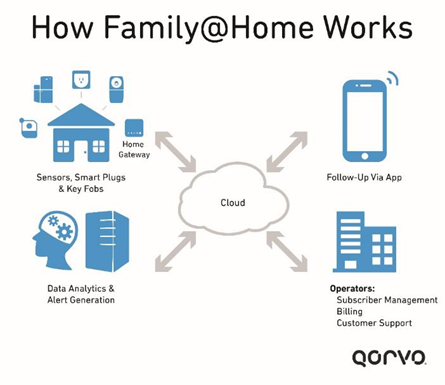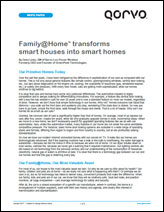Smart Home Services – A Window of Opportunity for Operator Success
March 8, 2016
The world's cable and TV operators are facing increasing competition in their core business, providing "free" television and pay channels for entertainment.
Internet provisioning is commoditizing entertainment. Traditional TV is being replaced by streaming solutions and is very popular amongst the younger generation in particular. Over the top programming from companies like Netflix, Amazon Prime, and others, as well as pay TV providers like HBO and Showtime, are removing much of the demand for entertainment content delivered by the cable companies, reducing subscribers and overall revenues. Live sports, news and talk shows are key for operators today.
This evolution in customer demand and behavior is motivating operators to increasingly innovate to find new services and revenue streams and the answer could be smart home services.

Over the last five years or so, there has been a great deal of interest, chatter and hype about the smart home and the Internet of Things. Much of the tech industry has decided to pivot around this immense new market opportunity. Consumers are excited – they want smart home services. Solution providers and tech companies in a wide variety of market sectors see this as a potential trillion dollar a year industry and they all want a part of it.
However, there are challenges regarding interoperability and communications as the industry seems fragmented. Apple is battling against Google who is fighting against Intel, Qualcomm and Samsung. It seems that nearly every month, a new industry group or consortium emerges that promises to resolve this battle, but in fact, makes it more complicated for consumers and application designers to make a decision.
Despite the current market confusion and uncertainty, the demand for smart services provides a wonderful opportunity for the world's cable TV operators who need new revenue services to replace the cord cutting.
Operators have a tremendous customer base. They have all the systems in place for marketing, billing, call centers for support, trucks (or small vans) on the road. Many of the large operators are already rolling out smart home services like home security and environmental control on a limited basis. However, there is a much bigger opportunity waiting that is just starting to emerge.
Family@Home could be the answer.
Family@Home services bring in a Smart Home Butler that helps the family live their lives securely, more efficiently and more comfortably. More than just a network of web connected devices, this is an entire intelligent service that combines inputs from a diverse variety of sensing and input devices in a house and enables easy management and control of most of the home's systems and appliances.
The first step is the use of various sensors that provide data to the cloud regarding the home's environment as well as the whereabouts of the individual members of the household. In addition to the family members, it can also include parents, grandparents, kids and even pets. This data, over a period of time, is uploaded to the algorithm in the cloud, and then stored and analyzed via data analytics to create behavior patterns so that the system actually learns how the family lives – where they normally are at specific times, who is usually in the house and when.

If the kids usually get home from school at 3pm, and the system senses that people are entering the home at 11am, it recognizes the anomaly and can send an alert to the parents. If the system knows that everybody usually is out of the home by 8am, and it recognizes that doors have been left unlocked, it can automatically close and lock them. If the heating system has been left on and the home is empty, the Family@Home system recognizes the issue and turns it off, improving energy efficiency.
But the system has additional capabilities. For example, suppose the water heater in the basement springs a leak. In addition to recognizing the problem and sending an alert to the home owner, it can actually turn off the water flow, limiting the damage and the expense of wasting water and energy.
One common battle in families is shower time. Kids like taking long showers, which can be
expensive for both water use and energy consumption. By being able to isolate and monitor how
much energy and water is being used by specific members of the family, it may make it easier to
raise awareness and thereby manage those costs. A cloud-connected showerhead that turns off the
hot water after a certain time could also help with that water and energy conservation
lesson.
It is obvious that consumers worldwide would appreciate the Family@Home type of technology because it increases family security, safety and comfort, as well as increasing energy management awareness and reducing costs.
These kinds of family sense-and-management solutions are not complicated – they could be installed and maintained by the residents themselves. However, in a great number of cases, consumers would prefer that a knowledgeable third party come in and handle it. From initial installation to troubleshooting, the service providers who already have a presence in the home are ideally suited to handle this. As the operators already have a financial billing relationship with the household (cable TV, broadband, VoIP, cellular phones, home security, etc.), these additional services would be basically another line item on their monthly bill.
As cable companies and service providers face the financial challenge of "cord cutters," adding this new service to their offerings provides an easy-to-understand business incentive and a way to increase their bottom line.
The Family@Home technology is also of benefit for device and appliance developers and manufacturers. By working with these service providers, they can develop and partner their hardware and applications into the service offerings, providing a one-stop shop for consumers. In addition, by letting the service provider make the decision regarding which and what connectivity technology to use, they can eliminate yet another challenge in the development and manufacturing process.
The smart home is a solution that was seemingly designed for operators to sell. But they are not alone. Retailers or even product brand vendors experimenting with direct sales (internet) models are not sitting and waiting; they are eyeing this market as well. There is a window of opportunity – smart operators are recognizing it and are ready to move into this space.
Have another topic that you would like Qorvo experts to cover? Email your suggestions to the Qorvo Blog team and it could be featured in an upcoming post. Please include your contact information in the body of the email.

